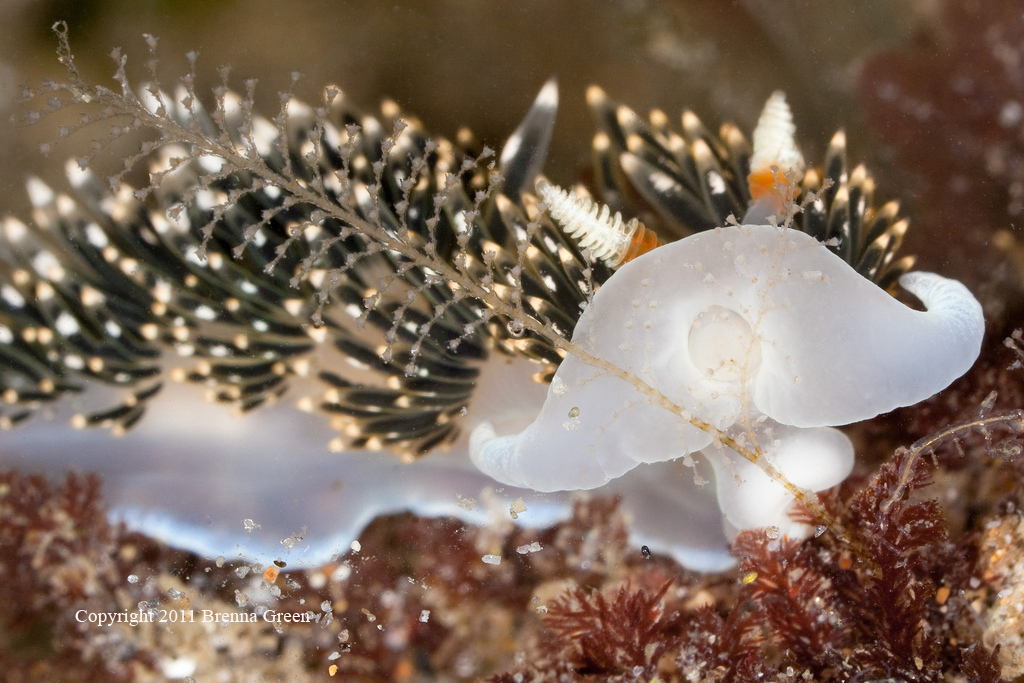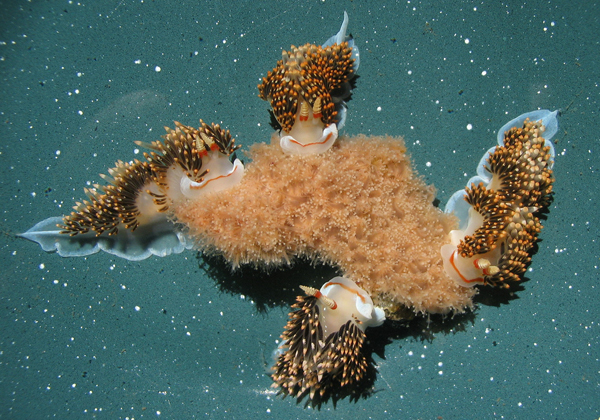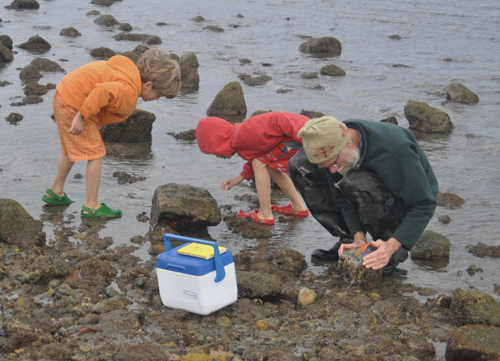 |
Phidiana hiltoni
feeding on hydroid PlumulariaPhoto courtesy of Brenna Green
Soquel Point, Santa Cruz County, CA
Canon 5D Mark II, Canon EF 100mm f/2.8 Macro lens, Sigma EM-140 DG ring strobe
Copyright 2011
Phidiana hiltoni Donoghue, 1927
(1) Anecdotes and flashbacks
From 1962 until McDonald’s (1983) synonymy, ‘branchers knew Phidiana hiltoni as P. pugnax, the apt name given by the late Jim Lance to this large aeolid for its habit of “attacking and dismembering other aeolids upon accidental contact” (Lance 1962). Jim presented no other information about its diet, and before long this had become one of those undocumented anecdotes entrenched in the literature. As one example, Thompson (1976) wrote “Phidiana pugnax feeds chiefly upon other aeolid nudibranchs.” After being recognized as Phidiana hiltoni, the aeolid was even noted as pondering the existence of God (Behrens 1998, BOW # 25 -sorry, Dave, I just couldn’t resist), reminding me of that classic scene in Cannery Row, when Doc answers Hazel’s innocent question about why black stinkbugs put their tails up in the air with, “I think they’re praying.” But enough of the metaphysical. In December 1992 I was visiting my folks in Marin County and knowing some good low tides were coming up, called Terry Gosliner to see if he’d like to take a trip to Duxbury Reef, the humongous shale reef where we had independently cut our teeth on ‘branchs as kids. Terry was game, and as a bonus, said that Dave Behrens would be visiting and could join us.
December 21st dawned with wind and rain, and I was uncertain if the hour drive out to Duxbury would be worth it, but on the other hand, how often does the student get to join the Masters? That afternoon, as we made our way down the bluffs to the reef, the wind had died and the skies were parting, our wish come true. Living on the Oregon coast at the time, not only was I blinded by the sun, but I hadn’t been to Duxbury in years, and was as surprised as Terry and Dave, when practically as soon as we hit the tidepools, there were all these fat Phidiana hiltoni (hereafter Phidiana) crawling at our feet. Until the 1970’s, Phidiana was known as far north as Monterey. I had found them in Santa Cruz County starting in late 1977, and then Bill Pence and Douglas Mason found them at Pillar Point in San Mateo County in 1991, but as far as we knew, this was the first time the aeolid had made the jump to Marin. Anyway, we spent a fine afternoon, finding between us a respectable 24 species of ‘branchs. As we headed to the seaward edge of the Reef to watch the setting sun, first I found a large red abalone shell, freshly empty and strikingly iridescent green on the inside, and then we were treated to a vivid Green Flash that led to simultaneous, stunned exclamations. Quite a winter solstice.

Phids at the trough: Phidiana hiltoni preying on the hydroid Hydractinia
|
(2) Diet and impacts
Terry, on his subsequent visits to Duxbury, continued to find Phidiana, but also noticed that other nudibranchs, particularly aeolids, just did not seem as abundant as in the ‘60s and 70’s. With the passing of the decades, hair - at least what’s left of it - grays, and field data – if it is gathered with care and survives the occasional natural disaster and all those tedious household moves – becomes “historical data,” a semi-precious commodity in the these days of climate-change and the relative dearth of long-term ecological studies that might illuminate what actually was. So Terry, John Pearse (Emeritus Professor of Biology at UCSC, and sponsor of my Senior Thesis on nudibranchs at UCSC) got a three-year research grant from California Sea Grant to combine our historical data on nudibranchs with new sampling from the same sites to try to figure out what was underlying the seeming decline in intertidal nudibranchs in central California, and if climate variation and change might have played a role. As part of this we decided to investigate the potential role of Phidiana hiltoni in the declines at Duxbury Reef.
First, we examined the diet of Phidiana in the wild and conducted laboratory trials presenting Phidiana other species of nudibranchs (owing possibly to the influence of anecdotes accepted as fact, no one had done this – or at least reported on it – using Phidiana). Based on the results of the diet studies, behavioral trials, and taxonomic affinity (i.e., relatives of Phidiana from the North Atlantic have been shown to consume aeolids, but not dorids), we grouped nudibranchs from Duxbury Reef according to their demonstrated or inferred vulnerability to predation by P. hiltoni. We then utilized historical abundance data from Duxbury Reef and two other sites, combined with recently obtained survey data from all three sites, to compare the abundance of these two groups at each site before and after the arrival of P. hiltoni.
The gist? Well, Phidiana eats a lot of hydroids, particularly Plumularia as in Brenna Green’s image (from a tidepool near Santa Cruz), as well as Hydractinia, as first reported by McDonald and Nybakken (1978), and solitary corals, as documented by Hans in BOW # 725. Lance was also correct. Phidiana does attack and consume other nudibranchs, particularly small aeolids and dendronotids that specialize on the same hydroids consumed by Phidiana http://www.flickr.com/photos/34486353@N07/3492068932/in/set-72157612784841131 . At Duxbury Reef, where local currents appear to have concentrated Phidiana (which has a short larval stage), nudibranchs vulnerable to Phidiana did decline in abundance after Phidiana arrived, likely owing to both competition for hydroid prey, as well as direct predation.
Despite a number of strong La Niñas, as well as a return to a cool phase of the Pacific Decadal Oscillation, Phidiana has persisted in abundance at Duxbury Reef, and its northward range expansion since 1977 may portend other changes in store for the nudibranch fauna of the northeast Pacific Ocean as our climate warms.
For those interested, more on our study and results can be found below in the link to Goddard et al. (2011).
References
Goddard JHR, Gosliner TM, and Pearse JS (2011) Impacts associated with the recent range shift of the aeolid nudibranch Phidiana hiltoni (Mollusca: Opisthobranchia) in California. Marine Biology doi:10.1007/s00227-011-1633-7 Available from: http://www.springerlink.com/content/jm9758738601m662/fulltext.pdf
Lance JR (1962) Two new opisthobranch mollusks from southern California. The Veliger 4:155-159
McDonald GR, Nybakken JW (1978) Additional notes on food of some California nudibranchs with a summary of known food-habits of California species. The Veliger 21:110-119
McDonald GR (1983) A review of the nudibranchs of the California coast. Malacologia 24:1-276
Thompson TE (1976) Biology of opisthobranch molluscs, Vol. I. Ray Society, London
Los Olivos, Santa Barbara County, CA
Apr., 2011
Send Jeff email at goddard@lifesci.ucsb.edu
Photo courtesy of Hans Bertsch

|
